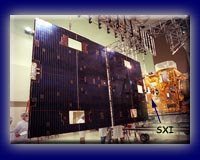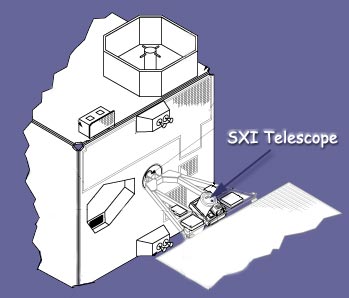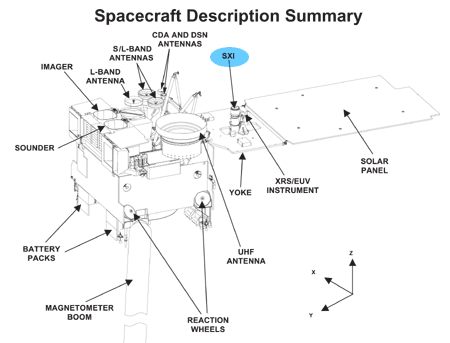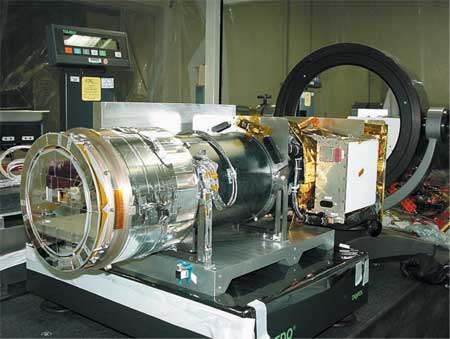|

|
| Data
Notes |
 |
SXI Operations
The GOES Solar X-ray Imager is integrated into the GOES-12 satellite,
whose primary mission is to provide Earth-weather monitoring. The SXI
is operated by NOAA's National
Environmental Satellite, Data, and Information Service.
NOAA's Space Weather Prediction
Center (SWPC) receives the telemetry stream directly from SXI
onboard GOES-12, processes the data, and integrates the observations
into their space weather alert and prediction services. The data are sent
in real time to NOAA's National
Geophysical Data Center (NGDC) where they are immediately
made available to the public, and preserved in a secure archive for
future research. Extensive general information about the GOES program
is available from NASA's
GOES Project Office. |
 |
SXI Observation Sequence
The geosynchronous orbit of GOES allows it to have direct line-of-sight
observations of the Sun, 24 hours/day, 7 days/week. The only exception
to this, is near equinox, when GOES enters Earth's shadow for up to one
hour each day. SXI will collect an image once per minute and the
exposure settings follow a sequence that is optimized to observe three
primary phenomenon as they are reflected in the Solar atmosphere:
coronal structures, active regions, and solar flares. |
 |
GOES Space Weather Mission
NOAA operates a series of meteorology observing satellites known as
Geosynchronous Operational Environmental Satellites (GOES). Even though
the weather pictures from GOES are seen nightly in our living rooms via
the local weather broadcast, few people know that GOES also monitors
space weather via its onboard Space Weather Prediction Monitor (SEM) system.
Until 2001, NOAA monitored monitored three prominent space weather
parameters: energetic particles (EPS), magnetic
field (MAG) and the total X-ray output of the Sun (XRS).
In the summer of 2001, NOAA also began to monitor the structure of the
solar atmosphere via the Solar X-ray Imager (SXI).
The XRS primary function is to provide a sensitive
means of detecting the beginning of solar flares--explosive events on
the Sun's surface that are fueled by the intense magnetic fields that
accompany sunspots. The larger solar flares can cause massive ejections
of solar matter which reach all points in the solar system and are
measured by EPS. Solar activity can also cause
disturbances in the solar wind which can propagate to Earth and disturb
our local magnetic field. MAG measures fluctuations
near the boundary of that field which are used to correlate with the
world-wide system of ground-based magnetometers. SXI
measures the X-ray flux of the Sun in a 512 x 512 grid, these million+
pieces of information are then combined to make a single image of the
Sun in X-rays. |
 |
GOES SXI File Naming Convention
Image data:
SXI_yyyymmdd_hhmmssfff_pv_nn.FTS (29 characters)
'yyyymmdd_hhmmssfff'
UTC date (DATE_OBS). The fff section represents fraction of a second.
'p' data
product code, i.e.,
p = 'A'
=> Level-0
p = 'B'
=> Level-1 The remainder of the alphabet is available for
Level-2 product codes.
'v'
processing version code, i.e., Reprocessed data will be differentiated
by incrementing the version code.
'nn'
satellite ID (i.e., GOES-nn) |
 |
GOES SXI Image Format
SXI archive images will be written in the Flexible
Image Transport System (FITS) format. These files
have been designed to be compatible with the SOLARSOFT
image processing environment. Libraries for reading FITS are available
for many languages including IDL,
C, and JAVA. A nice stand-alone viewer is also
available for Windows (FITSview). |
 |
Satellite Specific Data Notes for GOES-12
and GOES-13
|
|
GOES-12 SXI
|
 |
The
NOAA Goes-12 Solar X-Ray Imager (SXI) 1. Instrument, Operations, and
Data (.6 MB PDF), Dr.
Steven Hill, et al.
The
NOAA Goes-12 Solar X-Ray Imager (SXI) 2. Performance (3.6 MB PDF),
Dr. Vic
Pizzo, et al.
|
 |
GOES-12 SXI Instrument
Specifications
The SXI section (pdf) of the official
GOES
Data Book
contains detailed information about:
- Instrument Design
- Operations
- Imager Performance
- Telescope Assembly
- Filters
- Sun sensor
- Power

|
 |
GOES-12 SXI Instrument
Summary
- The SXI telescope images the sun in wavelengths
ranging from soft X-rays to extreme ultraviolet. These filters are
available [#, wavelength in angstroms, filter name, (Metadata entry)]
- 01, 6-65, Poly thin (P_THN_A)
- 02, UV, UV diffuser
- 03, 6-65, Poly thin (P_THN_B)
- 04, 6-60, Poly medium (P_MED_B)
- 05, 6-20, Be thin (B_THN_B)
- 06, 6-16, Be medium (B_MED)
- 07, 6-12, Be thick (B_THK)
- 08, 0-0, Radiation shield (RDSH)
- 09, 6-80, Open (OPEN)
- 10, 6-20, Be thin (B_THN_A)
- 11, 6-50, Poly thick (P_THK)
- 12, 6-60, Poly medium (P_MED_A)
- Each image is a 512 x 512 array with 5 arcsec
pixels.
|
 |
GOES-12 SXI Metadata
- The browse display includes a drop list
containing a short set of metadata:
- DATE_OBS - Earth-adjusted time of
observation, UT
- IMG_CODE - Intent of the images:
- FL = Flares
- CS = Coronal Structures
- AR = Active Regions
- BG = Background
- TST = Test
- MSFC = Startup sequence
- WAVELENGTH - filter name.
- MCPGAIN - Microchannel Plate detector gain
setting in volts.
- EXP_TIME - measured exposure duration..
- IMG_WDI - Whole disk intensity (units TBD)
- IMG_MIN - Image minimum intensity (units
TBD)
- IMG_MAX - Image maximum intensity (units
TBD)
- SAT_PIX - Saturated pixel count.
- Filename.
A complete copy of the SXI image file header
information, for each image, is contained in a relational database. For
a description of the content of the metadata, see the Level-0 and Level-1 keyword
descriptions.
|
 |
GOES-12 Image Sequences
Through 2004-12-14.
View a summary (pdf,
xls)
of all the image sequences taken by SXI, including 2001 post launch
tests. The summary lists the first image in each sequence change and
provides a brief description of what was done in the sequence (eg.,
3-filter patrol, UV-bulb test images, MCP-gain testing, etc.). This
information was provided by Vic.Pizzo@noaa.gov. |
 |
GOES-12
New SXI Coronal Hole Product
Beginning on Dec 15, 2004, NOAA/Space Weather Prediction Center started
routine production of a coronal hole image product. This product is
created 4 times per day (01:00, 07:00, 13:00, and 19:00 UT), for the
purpose of identifying coronal holes, and they become available at
approximately 08:00, 14:00, 20:00, and 02:00 UT. Each coronal hole
image is created from a sum of 12 hours of images (corrected for solar
rotation), spanning the period 6 hours prior to the nominal coronal
hole image time to 6 hours after . The coronal hole image is composited
from 3-second integration, Level-1 (calibrated) images taken through
the Thin Polyimide (PTHN) filter.
The need to create this new
product was driven by the loss of the ability to use the SXI Open
Filter position and by anomalous high voltage power supply (HVPS)
behavior. The inability to use the Open Filter was caused by the
failure of at least 1 of the 6 entrance filters that normally shield
the SXI optics from visible and ultraviolet light. The HVPS behavior
has forced imaging to be conducted at a lower than desired gain.
The SXI Coronal Hole product
is now available online. View these data in the Browse and Movie
sections. View coverage in the Summary section, and download the data
in the Search sections.
Contact Doug.Biesecker@noaa.gov
if you have questions.
|
 |
GOES-12 Links
January 30, 2003: NOAA Press Release: SXI
Enters Operations
August 13, 2001: NOAA Press Release: GOES-12
Reaches Orbit.
July 23, 2001: NOAA Press Release: GOES-M
Launched.
June 21, 2001: NOAA Press Release: GOES-M
Ready for Launch.
June 26, 2001: CNN News
Brief
NOAA's Office of Satellite Operations: http://www.oso.noaa.gov/
Real Time GOES Weather Imagery from the Univ. of
Wisconsin: https://www.ssec.wisc.edu/data/index.html
NOAA's Space Weather Prediction Center: http://swpc.noaa.gov/
NASA's GOES Project: https://goes2.gsfc.nasa.gov/
National Solar Observatory: https://www.solarviews.com/eng/sun.htm
Sun Facts: https://www.fragrancex.com/Fragrance-Information/sun-facts.html
Storms in Space (NPR): https://www.npr.org/templates/story/story.php?storyId=123111882
Sun's Corona (NASA): https://www-istp.gsfc.nasa.gov/Education/wcorona.html
More Sun's Corona (NASA): https://imagine.gsfc.nasa.gov/docs/science/mysteries_l1/corona.html
The Sun in X-rays (NASA): https://pwg.gsfc.nasa.gov/stargaze/Sun6new.htm
Here's a couple of suggested links from Bright Futures Charter School:
Online Education - The Planets and Space Science
The 8 Planets - Just For Kids |
|
GOES-NOP SXI Under
Construction
|
 |
The GOES-N SXI, developed by Lockheed Martin
Advanced Technology Center (LMATC) in Palo Alto, California, uses a
telescope assembly to observe the sun's x-ray emissions and provide
early detection and location of flares. These observations allow space
weather forecasters to monitor solar features and activities such as
solar flares, loops, coronal holes, and coronal mass ejections-clouds
of charged particles shooting toward Earth-from the sun. Knowledge of
the location and size of these phenomena greatly improves the solar
forecaster's ability to predict which solar phenomena may affect the
Earth and its atmosphere and to determine when predictions and alerts of
space weather conditions that may interfere with ground and space
systems should be issued. Space weather can have quite far-reaching
effects. NOAA categorizes these as radio blackouts, radiation storms,
and geomagnetic storms. Radio blackouts interfere with military and
commercial communications and navigation systems. Radiation storms can
damage operating spacecraft and expose humans to excessive radiation
during high-altitude missions.
|
 |
GOES-NOP SXI Instrument
Specifications
The GOES
NOP overview brochure (4 MB pdf) describes the SXI instrument
in general terms beginning on page 17.



|
 |
GOES-NOP SXI Instrument
Summary
-
, chapter 6
contains the SXI instrument description.
- The SXI telescope images the sun in wavelengths
ranging from soft X-rays to extreme ultraviolet. These filters are
available:SXI_Filter_combos_NOP_Bld6.pdf
- Each image is a 512 x 512 array with 5 arc sec
pixels.
|
 |
GOES-NOP SXI Metadata
- The browse display includes a drop list
containing a short set of metadata:
- DATE_OBS - Earth-adjusted time of
observation, UT
- IMG_CODE - Intent of the images:
- FL = Flares
- CS = Coronal Structures
- AR = Active Regions
- BG = Background
- WAVELENGTH - filter name.
- VERLEVL1 - process version for the Level-1 product
- Filename.
The header key words for the Level-0 and Level-1
SXI images contain extensive information on the state of the SXI
instrument at the moment of collection.
For
a description of the SXI FITS header content, see the Level-0 and
Level-1 keyword descriptions.
|
 |
GOES-NOP Image Sequences
View a summary (pdf, xls) of all the image sequences taken by GOES-N
SXI. The summary lists the first image in each sequence change and
provides a brief description of what was done in the sequence (eg.,
3-filter patrol, UV-bulb test images, MCP-gain testing, etc.). This
information is (will be) provided by Vic.Pizzo@noaa.gov. |
 |
|
 |
GOES-NOP Links
Read about the GOES N,O, P satellite series: http://www.osd.noaa.gov/GOES/goes_n.htm
GOES-N Status: https://goes.gsfc.nasa.gov/text/goesnstatus.html
GOES-N Launch Timeline: https://www.spaceflightnow.com/delta/d313/050609launchtimeline.html
NASA's Live Launch Webcast site: https://www.nasa.gov/multimedia/nasatv/index.html
Mission Overview: https://www.nasa.gov/mission_pages/goes-n/main/index.html
Lockheed Martin SXI: https://www.spaceref.com/news/viewpr.html?pid=20321
|
 |
|
|